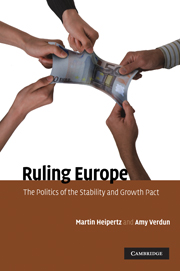Book contents
- Frontmatter
- Contents
- List of tables
- Foreword by Jean-Claude Juncker, Prime Minister of Luxembourg and President of the Eurogroup
- Preface
- Acknowledgements
- List of abbreviations
- 1 The politics of the Stability and Growth Pact
- Part I
- 2 States, intergovernmentalism and negotiating the SGP
- 3 Opening the box: A domestic politics approach to the SGP
- 4 The functional logic behind the SGP
- 5 The role of experts and ideas
- Part II
- Appendix
- Bibliography
- Index
4 - The functional logic behind the SGP
Published online by Cambridge University Press: 06 July 2010
- Frontmatter
- Contents
- List of tables
- Foreword by Jean-Claude Juncker, Prime Minister of Luxembourg and President of the Eurogroup
- Preface
- Acknowledgements
- List of abbreviations
- 1 The politics of the Stability and Growth Pact
- Part I
- 2 States, intergovernmentalism and negotiating the SGP
- 3 Opening the box: A domestic politics approach to the SGP
- 4 The functional logic behind the SGP
- 5 The role of experts and ideas
- Part II
- Appendix
- Bibliography
- Index
Summary
Presenting neofunctionalism
For many years neofunctionalism was the leading explanatory approach to European integration (Haas 1964; Lindberg and Scheingold 1970, 1971). Based on the ‘liberal’ or ‘idealist’ or ‘world order’ international relations theory that sought to explain regional integration after the Second World War, it became discredited when it was unable to account for the apparent setbacks in the process, i.e. the fact that its automatic mechanisms were evidently unable to account for integration reversals or stagnation.
Intergovernmentalism was the first theory to criticise the functionalist approach (Hoffmann 1966), but even Haas himself eventually agreed it had limitations (Haas 1975, 1976). The previously claimed automaticity of spillover principles could not be observed. However, during the 1990s a considerable number of scholars incorporated parts of the neofunctionalist principles into their theoretical approaches (Corbey 1995; Mutimer 1989; Tranholm-Mikkelsen 1991). The idea that integration in one area of policy-making could necessitate further decisions regained some of its attractiveness (cf. Börzel 2005; Niemann and Schmitter 2009; Risse 2005; Rosamond 2005; Schmitter 2004, 2005, 2009; Stone Sweet and Sandholtz 1998). Adherents to the approach were no longer concerned with the fact that the integrative principles could not always be observed and argued instead that the mechanisms they studied worked over longer periods of time, regardless of possible intermediate setbacks in the process of integration.
According to the neofunctionalist approaches, the players that matter most are supranational actors, supranational institutions and transnational elites (Deutsch et al. 1957, 1967; Stone Sweet and Sandholtz 1998).
- Type
- Chapter
- Information
- Ruling EuropeThe Politics of the Stability and Growth Pact, pp. 64 - 84Publisher: Cambridge University PressPrint publication year: 2010



